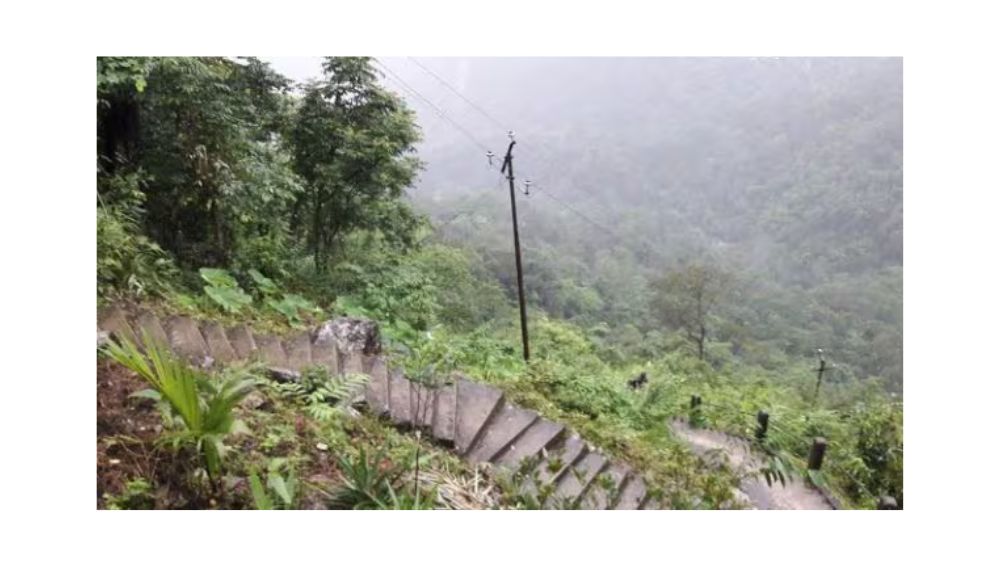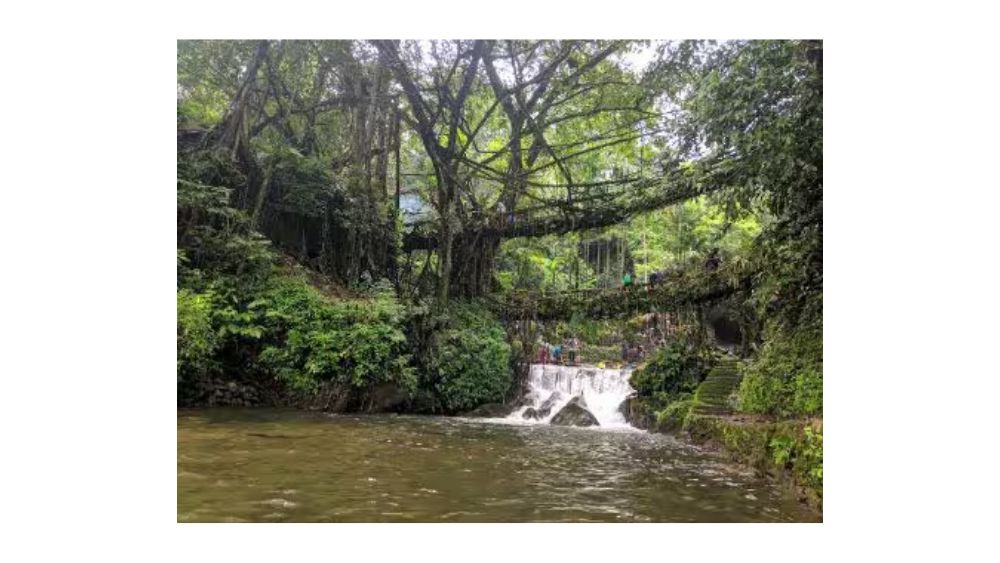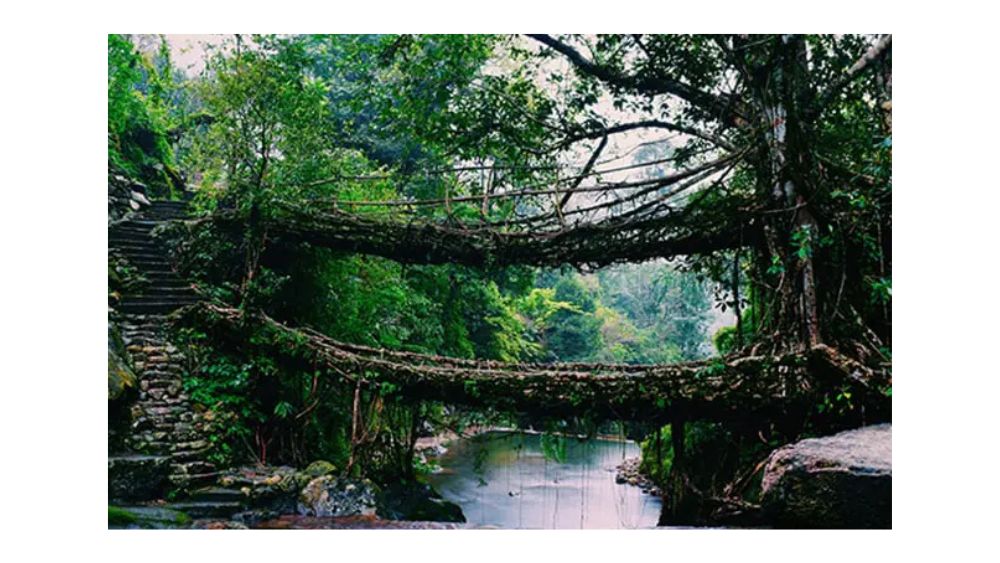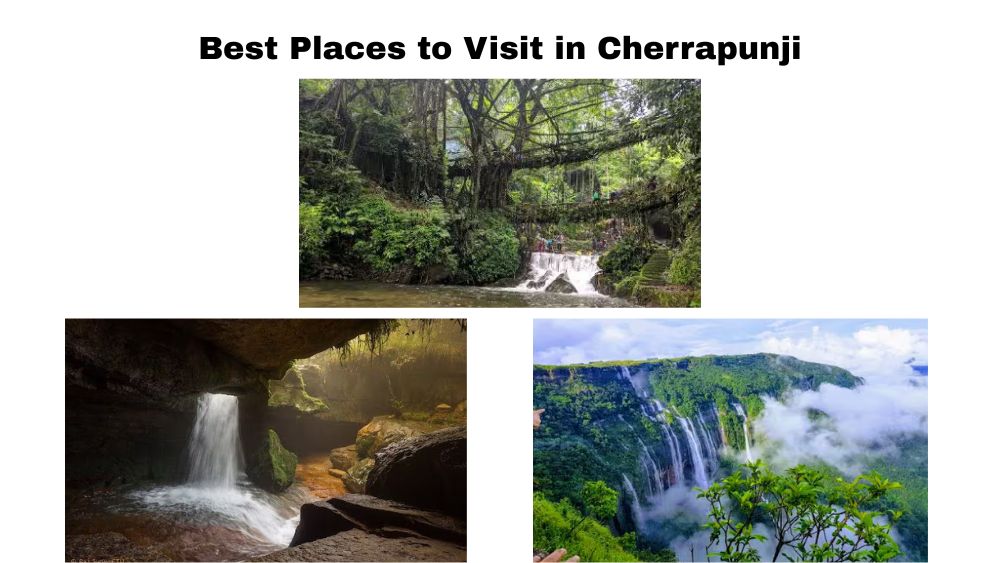Must-Visit Places in Cherrapunji for Unforgettable Trip
Table of Contents
Introduction
Best Places to Visit in Cherrapunji, nestled in the heart of Meghalaya, is a paradise for nature lovers and adventure seekers. Famous for its lush green landscapes, breathtaking waterfalls, unique living root bridges, and caves, it is one of the wettest places on Earth. Whether you’re looking for a peaceful retreat, an adventure-filled trip, or an exploration of Meghalaya’s rich culture, Cherrapunji has something for everyone.
1. Seven Sisters Falls, Cherrapunji

Introduction
Seven Sisters Falls, also known as Nohsngithiang Falls, is one of the most spectacular natural attractions in Cherrapunji, Meghalaya. This majestic waterfall consists of seven parallel streams, cascading down from a height of 315 meters (1,033 feet), making it one of the tallest waterfalls in India.
Located in the East Khasi Hills district, the falls are at their most stunning during the monsoon season, when the water flow is at its peak. This natural marvel offers breathtaking views and is a must-visit for nature lovers, photographers, and adventure seekers.
1. Location & How to Reach Seven Sisters Falls
- Location: Mawsmai, Cherrapunji, Meghalaya
- Distance from Shillong: 58 km
- Distance from Cherrapunji town: 1 km
How to Reach?
- By Air: The nearest airport is Shillong Airport (Umroi), about 80 km away. From there, you can take a cab or hire a taxi to Cherrapunji.
- By Train: The closest railway station is Guwahati Railway Station (150 km away). You can take a shared cab or bus from Guwahati to Shillong and then proceed to Cherrapunji.
- By Road: You can hire a private cab, take a shared taxi, or rent a bike from Shillong to reach Cherrapunji. The road trip is scenic, offering mesmerizing views of lush green valleys and misty hills.
2. Best Time to Visit Seven Sisters Falls
| Season | Weather | Waterfall Flow | Best for |
|---|---|---|---|
| Summer (March – May) | Pleasant (15°C – 25°C) | Moderate | Sightseeing & photography |
| Monsoon (June – September) | Heavy rainfall (12°C – 20°C) | Maximum flow, best views | Waterfall lovers, nature enthusiasts |
| Winter (October – February) | Cool & Dry (8°C – 18°C) | Low flow | Hiking, peaceful visits |
Best Time: June to September (Monsoon Season) – The waterfall is at its full glory, with all seven streams gushing down the cliffs. However, be prepared for heavy rainfall and mist.
For Comfortable Travel: October to April is ideal, as the weather is pleasant, and there is less rainfall.
3. Entry Fee & Timings
- Entry Fee: Free
- Timings: Open 24 hours, but best visited between 9:00 AM – 5:00 PM for clear views.
🔹 Pro Tip: Visit in the morning or late afternoon for the best photography opportunities when the sunlight enhances the beauty of the falls.
4. Features & Attractions of Seven Sisters Falls
A Waterfall with Seven Streams
- The seven segments of water symbolize the seven sister states of Northeast India: Arunachal Pradesh, Assam, Manipur, Meghalaya, Mizoram, Nagaland, and Tripura.
- The water originates from the lush green Khasi Hills and cascades down into the Bangladesh plains.
Stunning Panoramic Views
- The viewpoint near Mawsmai Village offers breathtaking panoramic views of the falls.
- On clear days, you can see Bangladesh in the distance.
Surrounded by Lush Greenery
- The falls are surrounded by dense forests, adding to the scenic beauty.
- Nearby caves and trekking trails make this spot perfect for adventure lovers.
A Spectacular Sunset Spot
- The sun setting behind the waterfalls creates a golden glow on the cascading water, making it an excellent spot for sunset photography.
5. Activities to Do at Seven Sisters Falls

1. Photography & Sightseeing
- The best viewpoint is located near Mawsmai village.
- The surrounding green valleys, misty hills, and the massive waterfall offer stunning frames for photographers.
- Best Time for Photography: Early morning and late afternoon.
2. Enjoy a Scenic Walk
- A short trek from the parking area leads to the main viewpoint, which provides a closer look at the falls.
- Walk around the area and take in the fresh air and tranquil environment.
3. Monsoon Adventure
- If you visit during the monsoon, you’ll experience the full force of the waterfall.
- Enjoy the dramatic views but carry rain gear, as the region receives heavy rainfall.
4. Visit Nearby Attractions
- Mawsmai Caves (1 km away): Explore limestone caves with stunning formations.
- Eco Park (2 km away): Offers a panoramic view of the waterfalls and Bangladesh plains.
- Thangkharang Park (3 km away): Another great viewpoint with a peaceful ambiance.
6. Nearby Attractions
1. Mawsmai Cave (1 km away)
- A limestone cave with narrow passages, stalactites, and stalagmites.
- Entry Fee: ₹20 per person.
2. Double Decker Living Root Bridge (18 km away)
- A unique 150-year-old bridge made by weaving roots of rubber trees.
- Requires a trek of 3,500 steps to reach.
3. Nohkalikai Falls (5 km away)
- The tallest plunge waterfall in India (340 meters).
- Offers a mesmerizing blue pool at the base.
4. Wei Sawdong Falls (7 km away)
- A hidden three-tiered waterfall, known for its turquoise blue waters.
- Requires a steep trek but offers stunning rewards.
7. Travel Tips for Visiting Seven Sisters Falls
Visit during monsoon (June–September) for the best waterfall views, but carry a raincoat and waterproof gear.
Wear comfortable shoes, as there is a short trek to the viewpoint.
Carry snacks and water, as there are limited shops nearby.
Avoid visiting in dense fog, as visibility can be very low.
Hire a local guide if you wish to explore caves or nearby trekking routes.
2. Laitmawsiang, Meghalaya
Introduction

Laitmawsiang, a hidden gem in Meghalaya, is a picturesque and offbeat destination known for its lush greenery, unique rock formations, natural caves, and cascading waterfalls. Located in the Khasi Hills district, this unexplored paradise is perfect for nature lovers, photographers, and adventure seekers looking for a serene escape away from the tourist crowds.
Also referred to as the Garden of Caves, Laitmawsiang is a must-visit if you want to explore Meghalaya beyond the popular spots like Cherrapunji and Shillong. The area is blessed with mystical caves, crystal-clear streams, and dense forests, making it one of the most scenic places in Northeast India.
1. Location & How to Reach Laitmawsiang
Location: Laitmawsiang, East Khasi Hills, Meghalaya
Distance from Shillong: 50 km
Distance from Cherrapunji: 25 km
How to Reach Laitmawsiang?
- By Air: The nearest airport is Shillong Airport (Umroi Airport), 65 km away. You can hire a taxi or take a shared cab from Shillong to reach Laitmawsiang.
- By Train: The nearest railway station is Guwahati Railway Station (135 km away). From Guwahati, you can take a cab or bus to Shillong and then travel to Laitmawsiang.
- By Road: Laitmawsiang is well-connected by road. You can hire a private taxi or take a shared cab from Shillong or Cherrapunji.
Road Trip Tip: The road journey from Shillong to Laitmawsiang is breathtaking, with scenic views of misty valleys, waterfalls, and dense forests.
2. Best Time to Visit Laitmawsiang
| Season | Weather | Best For |
|---|---|---|
| Summer (March – May) | Pleasant (15°C – 25°C) | Sightseeing, trekking |
| Monsoon (June – September) | Heavy rainfall (12°C – 20°C) | Waterfalls at full glory, lush greenery |
| Winter (October – February) | Cool & Dry (8°C – 18°C) | Peaceful visits, photography |
Best Time to Visit: October to April – The weather is pleasant, and it’s easier to explore the caves and waterfalls without heavy rain.
For Waterfall Lovers: June to September (Monsoon Season) – The waterfalls are at their most spectacular, but the area can be slippery.
3. Entry Fee & Timings
- Entry Fee: ₹50 per person
- Timings: 8:00 AM – 5:00 PM
Pro Tip: Visit early in the morning to experience the serenity and mist-covered landscapes before the crowds arrive.
4. Top Attractions & Features of Laitmawsiang
1. Garden of Caves – A Natural Wonderland
- Laitmawsiang is popularly known as the “Garden of Caves” due to its natural caves, unique rock formations, and lush greenery.
- The area is covered with mossy rocks, crystal-clear streams, and dense forests, making it a paradise for nature lovers.
2. Wah Rymben Waterfall – A Hidden Cascade
- One of the most scenic waterfalls in Meghalaya, surrounded by dense greenery.
- A perfect place for photography and relaxation.
3. The Secret Caves of Laitmawsiang
- The caves in this area are naturally formed over thousands of years.
- Some caves have mystical stalactites and stalagmites that add to the region’s beauty.
4. Pitcher Plant Garden
- This area is home to Nepenthes Khasiana, a rare carnivorous plant found only in Meghalaya.
- The garden showcases various exotic plant species unique to the region.
5. Mawsmai Cave – A Nearby Limestone Marvel
- Just a short drive away, Mawsmai Cave offers an incredible underground adventure with rock formations and narrow tunnels.
5. Activities to Do at Laitmawsiang

1. Explore the Garden of Caves
- Walk through the lush green pathways, natural pools, and rock formations.
- Best enjoyed early in the morning when the mist covers the caves and waterfalls.
2. Trek to Wah Rymben Waterfall
- A short trek through forests and hilly terrain leads to this breathtaking waterfall.
- Ideal for nature lovers, photographers, and adventure seekers.
3. Visit the Pitcher Plant Garden
- Witness one of the rarest carnivorous plants in the world.
- A fascinating experience for botany enthusiasts and nature lovers.
4. Photography & Nature Walks
- The rock formations, waterfalls, and misty landscapes provide endless photography opportunities.
- Enjoy a peaceful nature walk in the serene surroundings.
5. Cave Exploration
- Explore hidden caves that have been naturally shaped over thousands of years.
- Best done with a local guide for safety and insights.
6. Nearby Attractions
1. Cherrapunji (25 km away)
- Visit Nohkalikai Falls, the tallest plunge waterfall in India (340 meters).
- Explore the famous Double Decker Living Root Bridge.
2. Mawlynnong (50 km away)
- Asia’s cleanest village, known for its eco-tourism.
- Offers stunning viewpoints overlooking Bangladesh.
3. Mawsmai Cave (15 km away)
- Famous for its limestone formations and narrow passageways.
- A great spot for cave exploration.
7. Travel Tips for Visiting Laitmawsiang
Wear comfortable trekking shoes – The paths can be slippery, especially after rain.
Carry rain gear – Meghalaya’s weather can change quickly, even in non-monsoon months.
Bring snacks & water – There are limited food stalls near Laitmawsiang.
Respect nature – Avoid littering and preserve the beauty of this hidden paradise.
Hire a local guide – For a better understanding of the caves, waterfalls, and rare plants.
3. Double Decker Living Root Bridge, Meghalaya
Introduction

The Double Decker Living Root Bridge is one of the most unique and breathtaking natural wonders of Meghalaya, India. Located in the village of Nongriat, near Cherrapunji, this stunning bridge is made from the living aerial roots of the Ficus elastica tree (Indian rubber tree) and has been handcrafted by the Khasi tribes for centuries.
Unlike conventional bridges, this natural marvel is self-strengthening over time, making it an eco-friendly engineering masterpiece. If you love trekking, nature, and adventure, this is one place you must visit on your Meghalaya trip.
1. History & Formation of Double Decker Living Root Bridge
How Are the Living Root Bridges Made?
- The Khasi and Jaintia tribes of Meghalaya have been growing and maintaining these bridges for over 500 years.
- The roots of the rubber tree (Ficus elastica) are trained to grow over bamboo scaffolding, which guides them across rivers and streams.
- Over 15-20 years, the roots become strong enough to hold human weight and withstand heavy rainfall.
- The double-decker structure evolved as an engineering solution to extreme monsoon floods, with two layers of root bridges providing extra stability.
Why Are These Bridges Unique?
- They grow stronger over time instead of weakening like wooden or metal bridges.
- Eco-friendly and sustainable – They don’t harm nature and provide a natural alternative to man-made bridges.
- Can last for over 500 years with proper care and maintenance.
2. Location & How to Reach Double Decker Living Root Bridge
Location: Nongriat Village, Cherrapunji, Meghalaya
Distance from Shillong: 65 km
Distance from Cherrapunji: 12 km
How to Reach?
From Shillong to Tyrna Village
- Take a private cab or shared taxi from Shillong to Tyrna Village, the starting point of the trek.
- Travel Time: 2-3 hours (from Shillong)
- Taxi Fare: ₹2,000 – ₹3,000 (private cab), ₹300 – ₹500 per person (shared cab)
Trek from Tyrna to Nongriat
- Distance: 3 km trek (3,500 steps one way)
- Trek Duration: 1.5 to 2.5 hours (one way)
- Difficulty Level: Moderate to Difficult
- Guide Fee: ₹500 – ₹800 (optional but recommended)
3. Trekking to the Double Decker Living Root Bridge
Trek Route Overview:
- Start at Tyrna Village and descend 3,500 steep steps through dense forests.
- Cross two steel suspension bridges over scenic rivers.
- Pass through remote Khasi villages where locals offer refreshments.
- Finally, reach Nongriat Village, home to the Double Decker Living Root Bridge.
Trekking Difficulty:
Suitable for adventure enthusiasts & nature lovers
Beginners can do it with moderate fitness
Requires stamina due to the steep steps
Trekking shoes & water are essential
4. Best Time to Visit Double Decker Living Root Bridge
| Season | Weather | Best For |
|---|---|---|
| Summer (March – May) | Pleasant (15°C – 25°C) | Trekking & sightseeing |
| Monsoon (June – September) | Heavy rainfall (12°C – 20°C) | Lush greenery, but slippery trails |
| Winter (October – February) | Cool & Dry (8°C – 18°C) | Comfortable trekking, best photography |
Best Time to Visit: October to April – Dry and pleasant weather for trekking.
Avoid: Monsoon season (June – September) due to slippery steps and strong river currents.
5. Entry Fee & Timings

- Entry Fee: ₹50 per person
- Timings: Open 24 hours, but best to visit between 7:00 AM – 4:00 PM for a safe trek.
Pro Tip: Start early in the morning to avoid heat and crowds.
6. Features & Attractions of Double Decker Living Root Bridge
1. A Unique Two-Layered Bridge
- Unlike single root bridges, this one has two levels, making it stronger and more stable.
- A rare example of bioengineering by indigenous communities.
2. Surrounded by Lush Green Forests
- Located in a rainforest with exotic plants, butterflies, and birds.
- The misty, mystical atmosphere makes it a paradise for photographers.
3. Natural Pools for Swimming
- Crystal-clear blue pools near the bridge allow visitors to take a refreshing dip.
- Best spot to relax after the tiring trek.
4. Nongriat Village – A Remote Paradise
- A small Khasi village with a peaceful environment.
- Offers homestays for an overnight experience.
7. Activities to Do at Double Decker Living Root Bridge
1. Trekking & Adventure
- A rewarding adventure trek through dense forests.
- Cross hanging steel bridges over rushing rivers.
2. Photography & Sightseeing
- Capture one of the most unique bridges in the world.
- Lush greenery, waterfalls, and natural pools make for stunning shots.
3. Swimming in Natural Pools
- Enjoy a refreshing swim in the blue rock pools near the bridge.
- A great way to relax after the long trek.
4. Experience Local Khasi Culture
- Stay in Nongriat homestays for a night to experience Khasi hospitality.
- Try local Khasi food like Jadoh (rice & meat dish).
8. Nearby Attractions
1. Rainbow Falls (3 km from Nongriat)
- A hidden gem with turquoise blue water.
- Requires another 1-hour trek from the bridge.
2. Nohkalikai Falls (12 km from Tyrna Village)
- The tallest plunge waterfall in India (340 meters).
- Offers breathtaking panoramic views.
3. Mawlynnong (50 km away)
- Asia’s cleanest village with stunning viewpoints.
9. Travel Tips for Visiting Double Decker Living Root Bridge
Wear comfortable trekking shoes – The path has 3,500 steep steps.
Carry 2-3 liters of water – The trek is physically demanding.
Start early in the morning – To complete the trek in daylight.
Stay overnight in Nongriat – To explore more peacefully.
Avoid monsoon season – The trail becomes slippery & risky.
Conclusion
Cherrapunji, often called the “Land of Eternal Rain,” is a paradise for nature lovers, adventure seekers, and cultural explorers alike. From the breathtaking waterfalls like Nohkalikai and Seven Sisters Falls to the world-famous Double Decker Living Root Bridge, this magical destination in Meghalaya offers an unforgettable travel experience.
Whether you’re trekking through dense rainforests, exploring mystical caves, or simply soaking in the lush green landscapes, Cherrapunji has something extraordinary for every traveler. The region’s rich Khasi culture, friendly locals, and unique natural wonders make it a must-visit destination in India.
FAQs
1. Where is the Double Decker Living Root Bridge located?
The Double Decker Living Root Bridge is located in Nongriat Village, Cherrapunji, in the East Khasi Hills district of Meghalaya, India.
2. How do I reach the Double Decker Living Root Bridge?
Step 1: Travel to Tyrna Village (12 km from Cherrapunji, 65 km from Shillong).
Step 2: Trek 3 km down (3,500 steps) from Tyrna to Nongriat Village, where the bridge is located.
Step 3: The trek takes around 1.5 to 2.5 hours one way.
By Car: Private taxis from Shillong to Tyrna cost around ₹2,000 – ₹3,000.
By Public Transport: Shared taxis from Shillong to Cherrapunji and then to Tyrna cost ₹300 – ₹500 per person.
3. How difficult is the trek to the Double Decker Living Root Bridge?
Trek Difficulty: Moderate to Difficult
The trek involves 3,500 steep steps descending through dense forests.
Descending is easier but ascending back is challenging and requires stamina.
Takes 1.5 – 2.5 hours one way.
Best for: Fit travelers, adventure seekers, and trekking enthusiasts.
4. What is the best time to visit the Double Decker Living Root Bridge?
Season
Weather
Best For
Summer (March – May)
Pleasant (15°C – 25°C)
Trekking & sightseeing
Monsoon (June – September)
Heavy rainfall (12°C – 20°C)
Lush greenery, but slippery paths
Winter (October – February)
Cool & Dry (8°C – 18°C)
Comfortable trekking, best photography
Best Time: October to April for dry and comfortable trekking.
Avoid Monsoon (June – September): Trails become slippery and risky due to heavy rain.
5. Is there an entry fee for the Double Decker Living Root Bridge?
Yes, the entry fee is ₹50 per person.
6. Are guides available for the trek?
Yes, hiring a local guide is recommended.
Guide Fee: ₹500 – ₹800
Guides help navigate the trail safely and provide insights about the Khasi culture and bridge formation.
7. What should I carry for the trek?
Essentials for the trek:
Comfortable trekking shoes
2-3 liters of water
Light snacks/energy bars
Raincoat or poncho (if visiting in monsoon)
Extra pair of clothes (if planning to swim)
Camera or phone for photography
8. Can I swim near the Double Decker Living Root Bridge?
Yes! There are natural pools near the bridge with crystal-clear blue water where visitors can swim.
The water is cool and refreshing, perfect for relaxing after the trek.
9. How long does it take to visit the bridge and return?
Total Duration: 5 – 7 hours
Trek to the bridge: 1.5 – 2.5 hours (downhill)
Time at the bridge: 1 – 2 hours
Trek back: 2 – 3 hours (uphill, more tiring)
10. Is there accommodation available in Nongriat?
Yes! Nongriat offers homestays for an overnight stay.
Homestay Cost: ₹500 – ₹1,500 per night.
Staying overnight lets you explore more peacefully and visit Rainbow Falls (3 km away).
Disclaimer – The information provided in this blog is for general purposes only, and we recommend verifying details directly with local authorities as they may change over time.
By – travelloguide

